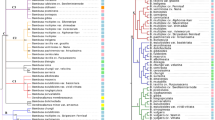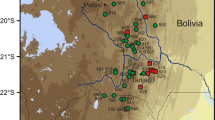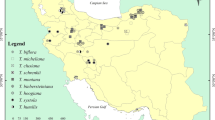Abstract
Some species belonging to the genera Galactia, Camptosema and Collaea from southern Brazil, Paraguay, Argentina, and Uruguay are grouped into a complex based on exomorphological affinities. The diagnostic morphological features sometimes overlap among species of different genera and dissimilar criteria have been adopted to delimit them, thus generating great taxonomic uncertainty. The aim of this work was to clarify the genetic relationships of the species within the complex as well as to analyze the infraspecific variability by means of analysing the AFLP band patterns. We examined 378 AFLP markers generated after amplification using six primer combinations. The monophyly of Collaea was supported, corroborating the present morphological classification. On the other hand, the results are not congruent with the current circumscription of Galactia and Camptosema, in agreement with previous phylogenetic hypotheses based on morphological characters and karyological studies, as both genera are polyphyletic.

Similar content being viewed by others
References
Bassam BJ, Caetano-Anollés G, Greshoff PM (1991) Fast and sensitive silver staining of DNA in polyacrylamide gels. Analytical Biochem 196:81–84
Bentham G (1859) Leguminosae. In: von Martius CFP (ed) Flora Brasiliensis 15 (1). Leipzig, pp 141–157
Bruneau A, Doyle JJ, Doyle JL (1995) Phylogenetic relationships in Phaseoleae: evidence from chloroplast DNA restriction site characters. In: Crisp MD, Doyle JJ (eds) Advances in legume systematics 7. Royal Botanic Gardens, Kew, pp 309–330
Burkart A (1952) Las Leguminosas argentinas silvestres y cultivadas, 2ª edición edn. Acme Agency, Buenos Aires, pp 400–413
Burkart A (1970) Las Leguminosas-Faseóleas argentinas de los géneros Mucuna, Dioclea y Camptosema. Darwiniana 16:175–218
Burkart A (1971) El género Galactia (Leguminosae–Phaseoleae) en Sudamérica con especial referencia a la Argentina y países vecinos. Darwiniana 16:663–797
Caicedo AL, Gaitán E, Duque MC, Toro Chica O, Debouck DG, Tohme J (1999) AFLP fingerprinting of Phaseolus lunatus L. and related wild species from South America. Crop Sci 39:1497–1507
Capo-chichi LJA, Weaver DB, Morton CM (2001) AFLP assessment of genetic variability among velvetbean (Mucuna sp.) accessions. Theor Appl Genet 103:1180–1188
Coulibaly S, Pasquet RS, Papa R, Gepts P (2002) AFLP analysis of the phenetic organization and genetic diversity of Vigna unguiculata L. Walp. reveals extensive gene flow between wild and domesticated types. Theor Appl Genet 104:358–366
de Queiroz LP, Fortunato RH, Giulietti AM (2003) Phylogeny of the Diocleinae (Papilionoideae: Phaseoleae) based on morphological characters. In: Klitgaard BB, Bruneau A (eds) Advances in legume systematics 10. Royal Botanic Gardens, Kew, pp 303–324
Doyle JJ, Doyle JL (1987) A rapid DNA isolation procedure for small quantities of fresh leaf tissue. Phytochem Bull 19:11–15
Felsenstein J (1985) Confidence limits on phylogenies: an approach using the bootstrap. Evolution 39:783–791
Fortunato RH (1994) Revisión del género Collaea (Leguminosae: Papilionoideae: Phaseoleae: Diocleinae). VI Congreso Latinoamericano de Botánica, pp 252 (abstract)
Fortunato RH (1995) A new species of Collaea (Leguminosae: Papilionoideae: Phaseoleae: Diocleinae) from Brazil. Kew Bull 50:795–799
Fortunato RH, de Queiroz LP (1998) Caracterización preliminar de los géneros Galactia, Collaea y Camptosema (Diocleinae–Phaseoleae–Papilionoideae–Fabaceae) en el Neotrópico. VII Congreso Latinoamericano de Botánica, pp 292 (abstract)
García RC (1989) Una novedad en el género Collaea (Fabaceae, Phaseoleae). Bol Soc Argent Bot 26:136–137
Goldblatt P (1981) Cytology and the phylogeny of Leguminosae. In: Polhill RM, Raven PH (eds) Advances in legume systematics 2. Royal Botanic Gardens, Kew, pp 427–463
Gottlieb AM, Giberti GC, Poggio L (2005) Molecular analyses of the genus Ilex (Aquifoliaceae) in southern South America, evidence from AFLP and ITS sequence data. Amer J Bot 92:352–369
Grisebach A (1874) Plantae Lorentzianae. Abh Königl Ges Wiss Göttingen 19:77–78
Han T, Marjo DJ, van Eck H, Jacobsen E (2000) Genetic diversity of Chilean and Brazilian Alstroemeria species assessed by AFLP analysis. Heredity 84:564–569
Izaguirre P, Beyhaut R (1999) Las leguminosas en Uruguay y regiones vecinas, parte 1: Papilionoideae. Editorial Agropecuaria Hemisferio Sur, Montevideo, pp 189–213
Kajita T, Ohashi H, Tateishi Y, Bailey CD, Doyle JJ (2001) rbcL and legume phylogeny, with particular reference to Phaseoleae, Millettieae and allies. Syst Bot 26:515–536
Kardolus JP, van Eck HJ, van den Berg RG (1998) The potential of AFLPs in biosystematics: a first application in Solanum taxonomy (Solanaceae). Pl Syst Evol 210:87–103
Koopman WJM, Zevenbergen MJ, van den Berg RG (2001) Species relationships in Lactuca s.l. (Lactuceae, Asteraceae) inferred from AFLP fingerprints. Amer J Bot 88:1881–1887
Lackey JA (1981) Phaseoleae. In: Polhill RM, Raven PH (eds) Advances in legume systematics 1. Royal Botanic Gardens, Kew, pp 301–327
Lara-Cabrera SI, Spooner DM (2004) Taxonomy of North and Central American diploid wild potato (Solanum sect. Petota) species: AFLP data. Pl Syst Evol 248:129–142
Mace ES, Lester RN, Gebhardt CG (1999) AFLP analysis of genetic relationships among the cultivated eggplant, Solanum melongena L., and wild relatives (Solanaceae). Theor Appl Genet 99:626–633
Martínez-Ortega MM, Delgado L, Albach DC, Elena-Roselló JA, Rico E (2004) Species boundaries and phylogeographic patterns in cryptic taxa inferred from AFLP markers: Veronica subgen. Pentasepalae (Scrophulariaceae) in the western Mediterranean. Syst Bot 29:965–986
Maxwell RH, Taylor DW (2003) Phylogenetic relationships of the Diocleinae with particular emphasis on the subgroups of Dioclea. In: Klitgaard B, Bruneau A (eds) Advances in legume systematics 10. Royal Botanic Gardens, Kew, pp 325–353
Nei M, Li W-H (1979) Mathematical model for studying genetic variation in terms of restriction endonucleases. Proc Natl Acad Sci USA 76:5269–5273
Page R, Holmes E (1998) Molecular evolution A phylogenetic approach. Blackwell Science, Oxford
Polhill RM, Raven PH, Stirton CH (1981) Evolution and systematics of the Leguminosae. In: Polhill RM, Raven PH (eds) Advances in legume systematics 1. Royal Botanic Gardens, Kew, pp 1–26
Saitou N, Nei M (1987) The neighbor-joining method: a new method for reconstructing phylogenetic trees. Molec Biol Evol 4:406–425
Saravanakumar P, Kaga A, Tomooka N, Vaughan D (2004) AFLP and RAPD analyses of intra- and interspecific variation in some Vigna subgenus Ceratotropis (Leguminosae) species. Austral J Bot 52:417–424
Schrire BD (2005) Phaseoleae. In: Lewis GP, Schrire BD, Mackinder M (eds) Legumes of the world, first edn. The Royal Botanic Gardens, Kew, pp 393–431
Sede SM (2005) Estudios multidisciplinarios en el complejo Galactia–Camptosema–Collaea (Leguminosae) Tesis Doctoral. Universidad de Buenos Aires, Buenos Aires, pp 1–191
Sede SM, Dezi R, Greizerstein E, Fortunato RH, Poggio L (2003) Chromosome studies in the complex Galactia–Collaea–Camptosema (Diocleinae, Phaseoleae, Papilionoideae, Fabaceae). Caryologia 56:295–301
Sede SM, Fortunato RH, Poggio L (2006) Chromosome evaluation of southern South American species of Camptosema and allied genera (Diocleinae–Phaseoleae–Papilionoideae–Leguminosae). Bot J Linn Soc 152:235–243
Swofford DL (2002) PAUP*: phylogenetic analysis using parsimony (* and other methods), Version 4b10. Sinauer Associates, Sunderland
Talhinhas P, Neves-Martins J, Leitão J (2003) AFLP, ISSR and RAPD markers reveal high levels of genetic diversity among Lupinus spp. Pl Breed 122:507–514
Taubert P (1894) Leguminosae. In: Engler A, Prantl K (eds) Die natürlichen Pflanzenfamilien III (3). Engelmann, Leipzig, pp 368–369
Tosto DS, Hopp HE (2000) Suitability of AFLP markers for the study of genomic relationships within the Oxalis tuberosa alliance. Pl Syst Evol 223:201–209
Varela ES, Lima J, Galdino AS, da S Pinto L, Bezerra WM, Nunes EP, Alves MA, Grangeiro TB (2004) Relationships in subtribe Diocleinae (Leguminosae, Papilionoideae) inferred from internal transcribed spacer sequences from nuclear ribosomal DNA. Phytochemistry 65:59–69
Vos P, Hogers R, Bleeker M, Reijans M, van der Lee T, Hornes M, Frijters A, Pot J, Peleman J, Kuiper M, Zabeau M (1995) AFLP: a new technique for DNA fingerprinting. Nucl Acids Res 23:4407–4414
Xu R-Q, Tomooka N, Vaughan D (2000) AFLP markers for characterizing the Azuki bean complex. Crop Sci 40:808–815
Acknowledgments
This work was developed at the laboratory directed by Dr. H. E. Hopp, Instituto de Biotecnología, CICVyA, INTA and represents a partial fulfillment for the requirements of a PhD degree by S. Sede. Special thanks are given to Verónica Nishinakamasu who kindly assisted us during the AFLP procedure. We wish to thank all the people who accompanied us during the collection trips in Argentina, especially to Cecilia Laporta, Fernando Fernández, Julián Greppi and Silvina Soto. We also thank Fátima Mereles, Lidia Pérez de Molas and Karem Elizeche for their help during the fieldwork in Paraguay. We acknowledge the invaluable support given by Guyra Paraguay and Moisés Bertoni Foundation who made possible two of the collection trips in Paraguay. This research was partly supported by International Association of Plant Taxonomists (IAPT), Research Grant Awards 2005 to Silvana Sede, by the Myndel Botanica Foundation, Collection trip Grant 2002 to Renée Fortunato and by UBACyT (EX212 and EX317) to Lidia Poggio.
Author information
Authors and Affiliations
Corresponding author
Rights and permissions
About this article
Cite this article
Sede, S.M., Tosto, D.S., Gottlieb, A.M. et al. Genetic relationships in the Galactia–Camptosema–Collaea complex (Leguminosae) inferred from AFLP markers. Plant Syst Evol 276, 261–270 (2008). https://doi.org/10.1007/s00606-008-0100-5
Received:
Accepted:
Published:
Issue Date:
DOI: https://doi.org/10.1007/s00606-008-0100-5




